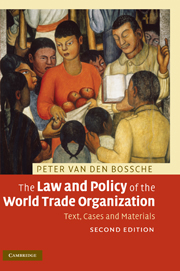Book contents
- Frontmatter
- Contents
- List of figures
- Preface to the first edition
- Preface to the second edition
- Table of cases
- Table of agreements
- 1 ECONOMIC GLOBALISATION AND THE LAW OF THE WTO
- 2 THE WORLD TRADE ORGANIZATION
- 3 WTO DISPUTE SETTLEMENT
- 4 PRINCIPLES OF NON-DISCRIMINATION
- 5 RULES ON MARKET ACCESS
- 6 RULES ON UNFAIR TRADE
- 7 TRADE LIBERALISATION VERSUS OTHER SOCIETAL VALUES AND INTERESTS
- 8 TOWARDS HARMONISATION OF NATIONAL REGULATION
- Epilogue
- Index
2 - THE WORLD TRADE ORGANIZATION
Published online by Cambridge University Press: 05 June 2012
- Frontmatter
- Contents
- List of figures
- Preface to the first edition
- Preface to the second edition
- Table of cases
- Table of agreements
- 1 ECONOMIC GLOBALISATION AND THE LAW OF THE WTO
- 2 THE WORLD TRADE ORGANIZATION
- 3 WTO DISPUTE SETTLEMENT
- 4 PRINCIPLES OF NON-DISCRIMINATION
- 5 RULES ON MARKET ACCESS
- 6 RULES ON UNFAIR TRADE
- 7 TRADE LIBERALISATION VERSUS OTHER SOCIETAL VALUES AND INTERESTS
- 8 TOWARDS HARMONISATION OF NATIONAL REGULATION
- Epilogue
- Index
Summary
INTRODUCTION
The World Trade Organization was established and became operational on 1 January 1995. It is the youngest of all the major international intergovernmental organisations and yet it is arguably one of the most influential in these times of economic globalisation. As Marco Bronckers stated, it has ‘the potential to become a key pillar of global governance’. The WTO is also one of the most controversial international organisations. It has been referred as ‘un gouvernement mondial dans l'ombre’. Guy de Jonquières of the Financial Times observed that the emergence of the WTO as a prime target for protests of many kinds reflects:
growing public awareness – but often imperfect understanding – of its role in promoting, and formulating rules for, global economic integration.
Many critics of the WTO claim that the WTO is ‘pathologically secretive, conspiratorial and unaccountable to sovereign States and their electorate’. According to Joseph Nye of the Kennedy School of Government of Harvard University, these detractors may, to some extent, have a case. Nye wrote in November 2000:
[Anti-globalisation protesters] assert that official transnational institutions like the World Bank and the International Monetary Fund are effectively accountable to no one. How true is their claim? Some defenders point out that the WTO, for example, is a weak organization with a small budget and staff, hardly the stuff of world government by fiat. […]
- Type
- Chapter
- Information
- The Law and Policy of the World Trade OrganizationText, Cases and Materials, pp. 75 - 167Publisher: Cambridge University PressPrint publication year: 2008



